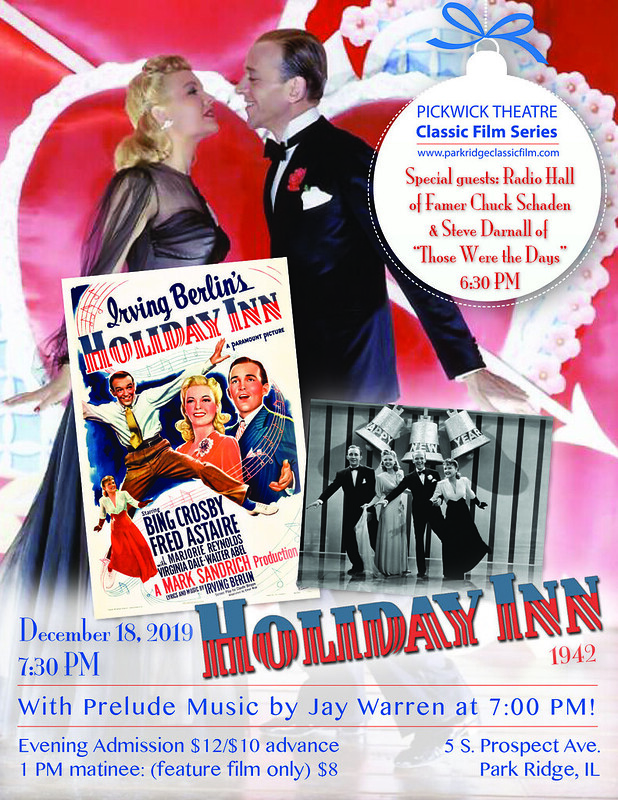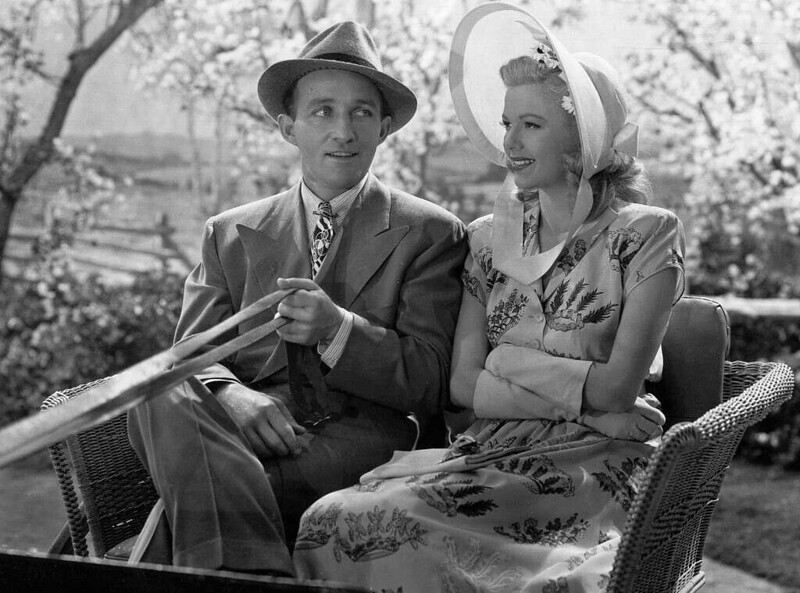WHAT: Holiday Inn (1942, DCP)
WHEN: December 18, 2019 1 PM & 7:30 PM
WHERE: Pickwick Theatre, Park Ridge, IL
WHAT ELSE: Radio Hall of Famer Chuck Schaden & “Those Were the Days” (90.9 FM) host Steve Darnall will be in the lobby at 6:30 PM. Chuck’s latest book, Chuck Schaden’s Radio Days, will be available for purchase. We will also have the “Nostalgia Digest” on sale.
Organist Jay Warren will provide pre-show music beginning at 7 PM!
HOW MUCH: $12/$10 advance or $8 for the 1 PM matinee. For advance tickets, Click Here!

Ted Hanover: I like it here… with you and Linda.
Jim Hardy: And we love having you. When are you leaving?
Holiday Inn (1942) is the perfect film for the holidays– all of them! Though not shown as often as White Christmas (1954), many fans consider it a superior film. The talents involved in its creation certainly elevate it to another level. Film historian Ken Barnes, in his exceptional audio commentary on the dvd, summed up the film’s unique qualities with one word: pedigree. Holiday Inn features two of the greatest entertainers of the 20th century– Bing Crosby and Fred Astaire– and showcases the songs of Irving Berlin. It’s the film that introduced “White Christmas,” the most popular song of all time sung by the most successful recording artist of the century. But there are other classic tunes like “Easter Parade,” which later became the title of another holiday classic. Adding to that special pedigree is the man behind the camera. Holiday Inn was directed by Mark Sandrich, who had helmed five of the nine films Astaire had made with Ginger Rogers at RKO.
Jim Hardy (Bing Crosby) and Ted Hanover (Fred Astaire) are a couple song-and-dance men with a musical act in New York City. They are also rivals when it comes to the ladies. Jim’s in love with their partner, Lila (Virginia Dale), but when she leaves him for Ted, Jim retires to the lazy life of an inn-keeper. After a short return to New York where he briefly meets aspiring performer Linda (Marjorie Reynolds), Jim puts his country inn to good use by turning it into a venue for musical acts– one that’s open for business only on the holidays. Linda comes calling in search of a job and becomes his partner. The dream is soon rattled by Ted, who appears at the inn after Lila has dumped him. He finds a new partner in Linda– to the chagrin of Jim. It’s another love triangle, but when Hollywood beckons– with the help of Ted’s agent Danny (Walter Abel)– everyone acts out various forms of deception to further their own ends. The madcap romance comes to a climax on a Hollywood movie set. When we see the stem of a smoking pipe tinkling the Christmas tree bells, we just know things will be all right.
The idea for Holiday Inn originally came from Irving Berlin, who wanted to put all the national holidays to song in a stage revue. The idea evolved into a movie scenario about an inn that is only open on the holidays. Having signed an exclusive contract with Paramount, Berlin came to Hollywood in 1940 to write all the songs for the film. He worked with producer-director Mark Sandrich, who loved the story idea. Sandrich, though, initially wanted Ginger Rogers and Rita Hayworth for the two female roles. However, with Crosby and Astaire in mind, casting two more stars would have been cost-prohibitive.
Holiday Inn was Bing Crosby’s twenty-second film for Paramount. The highest-paid star on the lot, Bing had had ten years of success with the studio going back to 1932’s The Big Broadcast. Prior to that, Crosby had been one of Paul Whiteman’s “Rhythm Boys.” Besides being on top of the “Hit Parade,” Bing established himself as a motion picture star of musical comedies. With his easygoing manner and knack for colorful language, his popularity soared throughout the 1930s and 1940s. This was a time when stars had personality. Today, some of his best-known films are the “Road” pictures he did with comedian Bob Hope. Through radio, film, and later, television, Crosby became one of the most popular entertainers of the century– a singing troubador whose influence is still felt in 2019, forty-two years after his death.
Bing performs “Easter Parade,” which became a film in 1948 with Judy Garland and Fred Astaire.

In his post-RKO years, Fred Astaire freelanced as an actor. Crosby and Sandrich wanted him for Holiday Inn and he gladly accepted, having worked with the director on some of the best films the two ever made, including The Gay Divorcee and Top Hat. Astaire was, of course, a genius and a perfectionist when it came to dancing, but he was also an effective singer who introduced some of the most memorable songs from the greatest songwriters of the period: George Gershwin, Jerome Kern, Cole Porter, and Irving Berlin.
The famous melodist Jerome Kern once said of Irving Berlin, “Berlin is American music.” Irving Berlin was serious about his music and how it was presented in film. Every song in Holiday Inn, even the background music, is a Berlin composition. But no other song is as famous as “White Christmas,” which was first introduced to audiences in this film. The song itself had been conceived around 1935 while Berlin was on the set of Top Hat. When it finally made it into Holiday Inn, it was not expected to be the hit it became. It was assumed that “Be Careful, It’s My Heart” would be the standout number.
Marjorie Reynolds had been a silent film actress with a career that went all the back to 1923’s Scaramouche. Initially, actress Joan Leslie was the first choice but was deemed too young. (Leslie would appear with Fred Astaire the following year in The Sky’s the Limit.) For her singing parts, Reynolds was dubbed by Martha Mears. Her finest moments in the film come with the “Be Careful, It’s My Heart” number in which she dances with Fred Astaire. Also in the cast was Virginia Dale, who played Lila. Although Dale had been part of a real-life song and dance act– having been discovered by Darryl F. Zanuck of 20th Century Fox– Holiday Inn would be her last musical.
One of the memorable scenes in Holiday Inn comes when Astaire’s Ted dances intoxicated on New Year’s. In order to come across as believably awkward on the dance floor, Fred actually did get drunk. According to his daughter, Ava, Fred had two glasses of whisky before the scene started and then one after each ensuing take; there were seven takes! Though Fred got sufficiently sloshed, he nevertheless managed to crash to the floor right on the beat!
The B Side of White Christmas: Fred Astaire & Marjorie Reynolds

The most notorious scene in the film, however, is the sequence in which Bing Crosby sings “Abraham” in blackface. Marjorie Reynolds also appears in this unfortunate makeup, but within the context of the story, this is being done so that Bing can keep her hidden from his rival. When the film was broadcast for television decades later, the whole scene was cut out. Such editing does a disservice to history by creating the impression the offensive material never existed. Holiday Inn is very much of its time. The film reflects the attitudes and conventions of the day, but this is not to suggest that the stars, particularly Bing Crosby, were racist. To adopt such a view is simply misguided.
The “Abraham” number, which is a celebration of President Abraham Lincoln from the black perspective (or rather, through black caricature), is performed minstrel-style. At that time, the most famous practitioner of blackface in film remained Al Jolson. Crosby, who was born in 1903, was heavily influenced by Jolson and grew up familiar with the tradition of the minstrel show of the 19th century. But Jolson was no racist, and even black artists like Ethel Waters admired the great Al Jolson. Bing, likewise, did not discriminate and was actually one of the few white singers in the business to work with black artists like Duke Ellington and the Mills Brothers. In fact, when Bing made Pennies From Heaven, he insisted that Louis Armstrong be cast against the wishes of the studio: “No Armstrong, no Crosby.”
The fact is the minstrel was a popular tradition at the turn of the century and remained so in popular entertainment through the 1940s. Bing would play the pioneer of the minstrel show, Dan Emmett, in Dixie and was seen in blackface yet again in Here Come the Waves. Even Fred Astaire had performed in blackface in his sincere tribute to “Bojangles of Harlem” in Swing Time. However, by 1954, years before the Civil Rights movement of the 1960s, the cast of White Christmas performed another minstrel-style number, but this time without makeup. It should be noted, however, that Holiday Inn, unlike White Christmas, features an important African-American character. The matriarch of the inn, who ultimately propels Bing into action, is played by Louise Beavers.
Astaire’s “Let’s Say It With Firecrackers,” which used real firecrackers and smoke, is the most explosive number in the film and was performed thirty-eight times by Astaire before he was finally satisfied with it. It’s certainly one of the great dance routines, and nothing like it exists in White Christmas! It is said to have influenced dance choreographer Bob Fosse. The filming of Holiday Inn lasted from November 1941 until February 1942. During the shoot, the Japanese attack on Pearl Harbor occurred, so a patriotic message was added to the Fourth of July sequence with Bing Crosby (as the “Freedom Man”) sporting an Uncle Sam hat as he introduces a military montage.
Holiday Inn received three Academy Award nominations and won for Best Original Song, “White Christmas.” The film became the 8th biggest money-maker of 1942– quite an accomplishment considering it was released late in the year in August. Its success later inspired a hotel chain to appropriate the name in 1952. Holiday Inn‘s greatest legacy, “White Christmas,” would become a seismic hit in the years to follow. In fact, the song had made its first public debut before the film was released. Bing sang it on his NBC radio show “The Kraft Music Hall” on Christmas Day 1941. During the war, Bing performed it often in front of troops abroad. With its connotations to family and home, “White Christmas” became an anthem for servicemen around the globe. This association between the song and its audience would be re-created in the more sentimental White Christmas (1954), which was neither a sequel nor a remake.
With its superb cast, witty screenplay, lively direction, exciting dance numbers– and the biggest song of all time– Holiday Inn remains the quintessential Hollywood musical and one of the great seasonal classics. The Pickwick Theatre Classic Film Series is honored to present this film for Christmas. We are equally honored to have with us in attendance Chuck Schaden, founder of old-time radio’s “Those Were the Days.” No doubt Bing sang “White Christmas” many times during the 50-year run of TWTD! Chuck will address the audience prior to the film screening at 7:30 PM.
~MCH